Chapter 23 Wild Life Conservation
The information on the next, two pages is given to visitors arriving at our properties.
B.A. and P. Farquhar Properties
The following five adjoining properties (comprising 27,930 ha 69,017 acres) are farmed as a single unit.
1. Wyambi - 2,428 ha (6,000 acres)
2,177 ha (5,380 acres) freehold, balance leasehold. This prop- erty has three big dams, extensive irrigation. Three barns, two sets of stock yards, machinery sheds. Bounded by Tomahawk and Boobyalla Rivers
2 East Wyambi - 1,747 ha (4,317 acres)
This property is bounded by the Boobyalla and Ringarooma Rivers and the Waterhouse Road. Although it contains no gravitation water schemes, the 25 kilometres of river frontage is suitable for irrigation purposes. The property is well developed, containing two barns, three sets of cattle yards and numerous waterholes.
Approximately 1,221 ha (3,017 acres) freehold and 526 ha (1,300 acres) leasehold.
3. Miegunyah - Approx. 8,701 ha (21,500 acres) all freehold
This property has two brick homes, four cottages, twenty stand sheanng shed, plus forty-five man shearers quarters, sheep yards and two barns. Two big dams, fifteen weirs, extensive irrigation and numerous waterholes. Bounded by Rock Bank, Cape Portland and Ansons Bay roads, Musselroe River and North Musselroe Bay
4. Rock Bank - 6,151 ha (15,200 acres) all freehold
This property has about 14 kilometres (9 miles) of ocean frontage to the West - Petal Point Road and Cape Portland to the North - 'Miegunyah' and Red Hills Road to the East and South. The property has two airstrips, two sets of cattle yards, extensive irrigation, seven weirs, one barn. The three cottages are sheltered by an abundance of natural she oaks. Plus slaughter house and sheep yards.
5. Rushy Lagoon - 8,903 ha (Approx. 22,000 acres)
This property is situated mainly on the western side of the Cape Portland road, southern side of Red Hills road. Frontages on Ringarooma, Musselroe Rivers. This property has one brick home, four cottages, workshop, office block, men's quarters, seed shed etc. One airstrip, one set of cattle yards and good river flats. Included four big dams, extensive irrigation, two weirs and numerous waterholes. Approximately 4,112 ha (10,160 acres) freehold and 4,791 ha (11,840 acres) renewable 20 year leasehold.
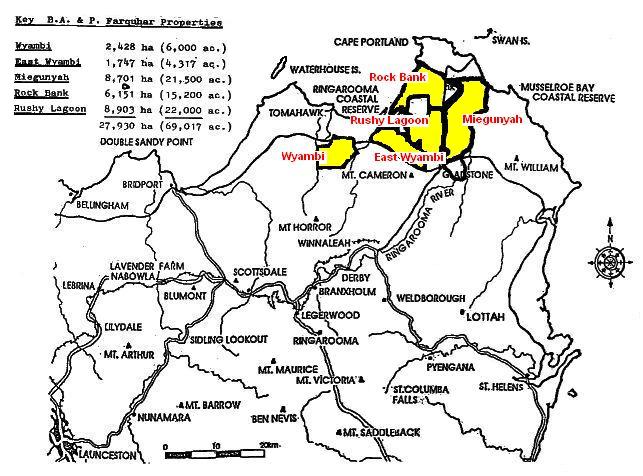
Map of NE Tasmania showing Farquhar properties
I have always been interested in birds as a vital part of the environment, and Peg knows more about individual birds than I do. John, when he was a little chap, used to get up early to watch the birds. He was really interested; he knew where every bird nested. He also had some pigeons, and knew each one individually. He would say, 'Big Bad Boy' will mate with 'Little Miss Bad Girl' soon. Within a few minutes 'Big Bad Boy' did mate with 'Little Miss Bad Girl'.
John was pleased when we made the three Wyambi properities bird sanctuaries. Apart from birds being aesthetically pleasing, they play a big part in controlling grubs, cockchafers, fluke and other pests.
David Probert, our overseer, who is in charge of the five properties at Wyambi, East Wyambi, Miegunyah, Rock Bank and Rushy Lagoon, (See details and map), is also very interested in birds. (Miegunyah and Rock Bank are part of Rushy Lagoon.) His knowledge of bird and animal life is quite remarkable, and he has the best pair of eyes for detail I know.
Graeme Propsting, whose son Michael flies David around the properties on some occasions, says David can focus on every detail from the air which is unusual. Dick Richey said that not many people had the ability or the quickness of eye to spot fish from an aeroplane; I am sure David could.
David is always the first person to spot a snake when we are walking through the bush. There is an abundance of snakes in our area, with the plentiful water supply, but they all have a part to play in the general environment.
This reminds me of when there was a shortage of water at Tomahawk and the snakes were thirsty. We had purchased Rushy Lagoon and had been working very hard so went to our cottage at Tomahawk for the weekend. There was a terrific smell in the house later that evening. We were sure there were dead mice somewhere. After a couple of days of investigation we found two big dead snakes in the big concrete water tank, plus a live one! Whenever we had turned the water on, apparently the putrid smell bad.stayed in the house. Luckily we had been drinking from another tank.
It worried me that we were all poisoning some of our birds when we poisoned rabbits and wallabies. We do not like poisoning, but unfortunately it is often the only way to keep some surplus wild native animals in check.
A kangaroo or wallaby need not breed each year, if the season is not suitable. The female kangaroo, when in season, calls a number of males and when she has plenty, say seven or eight, she stops; The boss male starts mating with her, then this makes the next biggest.jealous, so he challenges and when they start fighting, the next biggest starts mating with her. I have seen this happening when having my lunch in the bush. At the end of the mating the female is really exhausted, but she becomes pregnant. However, if the season is poor she need not give birth to the offspring for an indefinite period, depending on when there is sufficient feed.
When a grazier improves the pasture, the wallabies have one or two sets of joeys a year. Although we have about 12,000 cattle on our property, we would have in excess of this number of kangaroos and wallabies. The Parks and Wildlife ranger did a count of the wombats. During a night count he counted six a minute for an hour. He said we really had an excess of wombats on the property.
It is March 1990 and the duck season is about to start. It is something that many men look forward to from one year to the next, the annual duck season.
Some of our staff are very keen. They do not mind when they have to load fat cattle, whether it is the middle of the night, holidays or weekends, as long as it is not during the opening of the duck season!
I have never been a duck shooter, but it must be very exciting and
need a lot of skill to shoot flying ducks. When our son John left school,
to help on the farm, at sixteen years of age he was keen and enthusiastic
and did not want any privileges, being the boss's son. When Michael
Probert asked him what he wanted to do, he just said, Anything that
needs doing
.
After he had been working for about six months, he asked if he and David Probert (who is now our overseer of all properties) could have a week off in five month's time!
I told him that that would be fine as he had holidays owing. I
asked where were they going for this week's holiday, requested five
months in front. Oh, we are not going anywhere, but that is the date
of the opening of the duck season
.
Unfortunately John was drowned the following duck season from a duck boat.
This year a really nice chap unfortunately is dying of cancer, but he hoped he would live long enough to take part in the duck season. They usually leave home on the Friday night to be in position for the dawn of the opening of the duck season next morning. They take out tasty cookies and arrive back home on the Sunday. It is a real social occasion. I know that one time my son-in-law, Peter, had only sandwiches and was quite jealous of the others with their goodies. I think next year this was rectified and the goodies compared favourably with others. I think if I had to sit out in the cold and stand in water for hours, I would want the best of the cookies to eat.
Each shooter has his place and makes his hide of ti-tree or suitable material to blend in with the landscape. Some shooters use plastic decoy ducks to entice the wild ones to land.
Each person has his own particular place on the river or lagoon, often for a life time. No other person ever takes over another person's section, or there might be a proper shooting war. It is an unwritten law that everyone abides by.
All of our Wyambi properties are bird sanctuaries as are the man-made dams and channels on Rushy Lagoon. It would not be fair to try and stop the shooters on the rivers, as they have been shooting on these public rivers for fifty years.
It appears that the wild ducks need thinning out for a short period each year, or there would be too many for the feeding grounds, but the Parks & Wildlife know more about this than I do.
Peg and land the girls all love to see the wild ducks and swan on our waterways. It is wonderful how far they travel across Australia. John shot one duck from the Northern Territory and had it stuffed to display in his room.
Although it is necessary for us to poison at times to keep the rabbit and wallaby population down to a reasonable level, I have done everything I can to protect the bird life.
I read where the New Zealand Wild Life Service had found that, by colouring the birds' natural foods an unnatural colour, they kept them away, so we immediately dyed green any carrots we used for poisoning, and the birds did not touch them.
Mr. Frank Dowse, former Superintendent of Parks and Gardens in Launceston, also tried this out with grass seed very successfully. He took a bucket of grass seed, dampened the seed and mixed a handful of red ochre with it, and the birds did not interfere with his lawns.
We have worked on this same idea over many years. About twenty years ago I wrote to the Minister for Agriculture and Forests, suggesting 1080 poison be mixed with a dye before it was made available to farmers, but the Forestry and Agricultural Department poured cold water on the idea, so it was not implemented.
However, I continued to treat my own bait in this way, and a few years later when in Hobart I told the Director of Parks and Wildlife I could not understand that this simple, inexpensive method was not used, as one dollar's worth of dye would last for years.
He expressed interest and mentioned he had never seen the article nor had he been consulted. He immediately dictated a letter to the Forestry and Agricultural Departments telling them that dye had to be included in all uses of 1080.
Birds apparently regard the unnaturally coloured material as poisonous. I did an experiment on some ducks with mushrooms to see which were poisonous. I picked some coloured mushrooms from under the silver birch tree and threw them over the fence to the ducks. They started to gobble them up until the old drake flew at them and chased them away. Two of the ducks that ate the mushrooms died quickly and another one remained unconscious for twenty-four hours and then recovered. I was in the act of burying the three ducks the following day when I noticed slight movement from one and so postponed the funeral for another twenty-four hours.
The aborigines and bushmen used to watch the birds if they were not sure about edibility of any food. I am sure the ducks normally would not have eaten these mushrooms, but I thoughtlessly threw them over the fence. They were used to us throwing them good food over the fence.
This just shows how poisonous these coloured mushrooms are. The ducks died eating pieces of them. What would happen if little children were playing with them and then licked their fingers? Peg now gathers up all these coloured mushrooms from under the silver birch trees with a spade and sends them off to the dump.
We used to spray our pastures to stop army grubs and other pests, but we created a vicious circle by killing their natural predators too. So, during the past 22 years we have not sprayed anything on our pastures and cattle are healthier than ever. Nature has now built up a natural balance in the soil life.
We are fortunate that on our properties we have some 11 miles (17 kilometres) of beautiful, unspoiled ocean beaches. We also have 37 miles (60 kilometres) of river frontages on the Tomahawk, Boo- byalla, Ringarooma and Musselroe rivers. These are all beautiful streams, with a minimum of pollution. Mining activities years ago did partially spoil the rivers with silting, but now miners have stopped putting tailings into the rivers they are returning to their natural beauty. Musselroe Bay, adjoining our property, and many kilometres of beautiful beaches are all clean, lovely and peaceful in their natural state. How lucky we are to have these vast areas of unspoiled beaches and beautiful bays and rivers, mostly unknown to the general popula- tion, and certainly very few, if any people are encountered on these areas.
This reminds me of an incident in 1956 when visiting friends in California. They wished to do something special for me. So they decided to take me to an unspoiled, little known area of a beautiful river. We drove by car for some time, then we had to walk for a considerable distance carrying tubs of drinks, hampers of food etc. I was very fit, but we were all getting tired. However, I was at last assured that we only had one more hill to climb and then we would see the lovely river, which would be void of people.
Unfortunately it had been two years since they last visited this little known, secret place and when we tipped the hill, there was a new sealed road along the river with people and cars by the thousands!
We have many visitors wishing to look over the properties. One weekend recently, jn February 1990, we had 146 people, three bus loads of farmers and other interested people looking over the property. Many people from various parts of the State and interstate ring or write and ask can they be shown over the property.
This is not possible as it would fully occupy me or one of the staff just showing visitors around. However, when a bus load of people make forward arrangements, we generally manage to show them around the property and explain the irrigation system etc.
It really amazes me that people from all walks of life are interested in the property and our methods of operating the enterprise.
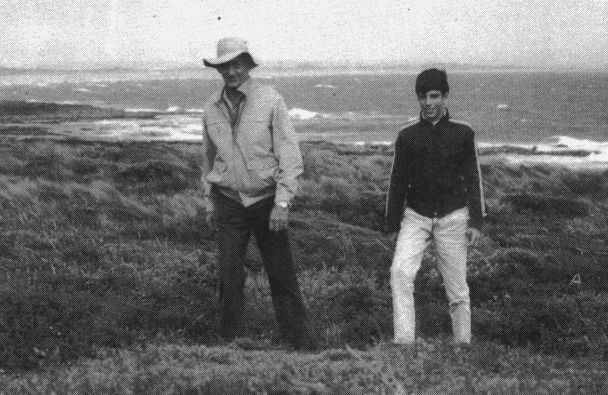
I am overlooking ocean with eldest grandson, Vishal.
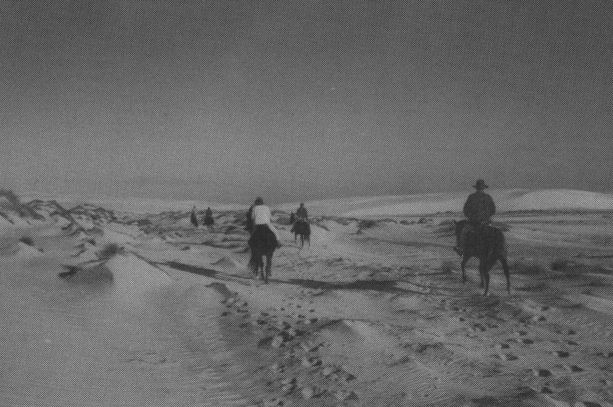
Riding along the beach to collect cattle.
We have had historical societies seeing the old water race, syphons and dams; farmers and others enquiring how we can still be economically competitive without using hormones to produce our beef, while others enjoy seeing the beaches, rivers, waterways, the trees, the cattle, sheep as well as the native animals.
We had the first Organic Farming and Gardening Society Seminar on Wyambi in 1973. We also hosted the Royal Agricultural Society of the Commonwealth when visitors from many parts of the world attended a field day at Wyambi in October 1985.
It has a lasting benefit when people tell you, years after a visit, that it was a memorable occasion for them, and how much they learned and enjoyed their visit to our property.
It is a rewarding experience to take around really enthusiastic people, whether they are local farmers, town people or overseas visitors.
We supply visitors with the following statistical information.
B.A. and P. Farquhar's 'Wyambi', 'East Wyambi', 'Mieguuyah', 'Rock Bank' and 'Rushy Lagoon' properties January, 1990.
Area: 69,017 acres (27,930 hectares).
Rainfall: 30 inches (750 mm).
Houses and cottages: 15 plus men's quarters, workshops, seed and stores buildings, shearing shed, quarters, stock yards, barns etc.
Airstrips: 3
Public Road Frontages: 37 miles (59 kilometres).
Ocean Frontages: 10.5 miles (17 kilometres).
River Frontages: Tomahawk, Boobyalla, Ringarooma and Musselroe Rivers -38 miles (60 kilometres).
Stock Water: 200 odd farm dams plus springs.
Irrigation Construction Programme 1986-90 completed:
33 miles (53 kilometres) of water races built and channels adjusted for
provision of holding weirs. 24 holding weirs completed. Installed
over 250 pipe culverts 25' x 34' (av.) in channels. This gives a total
of 108 miles (174 kilometres) of gravitation water races and channels
without a pump on the 108 mile length, but containing over 2.5 miles
(4 kilometres) of large cement syphons, plus 24 weirs.
Irrigation and Storage Dams: 11 dams plus 10 miles (16 kilo- metres) of channels with water held by numerous weirs etc. Total water available approximately 1,000,000,000 gallons (4,546,000,000 litres) or 4,546 megalitres (3,788 acre ft.)
Boobyalla and Musselroe Rivers renew and top up this storage water, so therefore onan average water available is probably con- siderably above these figures.
Stock on Properties:
Sheep and lambs:55,000 (av.)
Cattle (inc. calves):12,000 (av.)
Horses:40
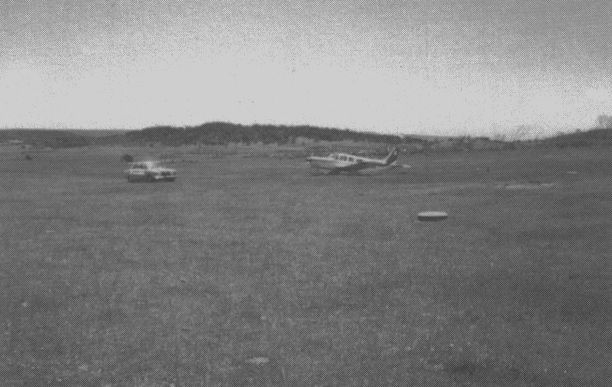
Visitors arriving at Rushy Lagoon airstrip.
Frank Jaeger, my previous sawmill partner, was the pilot on this occasion.
Tasmania is a lovely State and we have a wonderful area. We believe that we have enhanced its value and natural beauty with the dams, waterways and trees which we have added.
To see half a dozen riders bringing in a big mob of well- conditioned cattle or a few thousand lovely white-woolled sheep is a wonderful sight. The riders, horses, dogs all know their job and operate as a team without fuss or bother. When we took over Rushy Lagoon most of the cattle were wild and frightened, but with being gathered more regularly, worked and yarded, they now no longer run away to the same degree and walk down fencelines, look after their calves and are more docile. This makes it easier on the cattle because they do not knock themselves about, easier on the staff and on the fences.
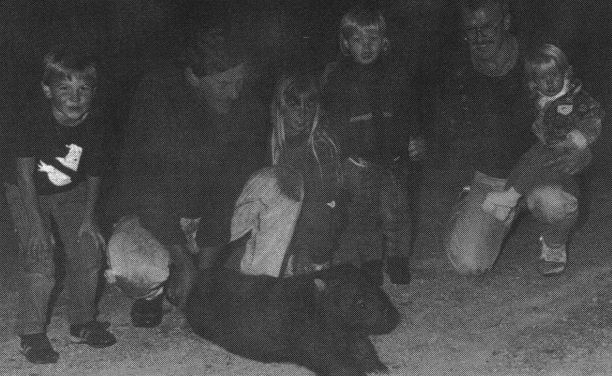
Roy Vogelpoel watched by his grandchildren, Antony and Michelle,
and business partner Russell Andrusko, holding daughter Elke, with son Kiran at his side looking at
a wombat prior to his release near the beach on Rushy Lagoon.
A company, Tasmanian Wildlife Observation Tours, in which we have an interest, has started an operation to bring special overseas tourists to view some of the wildlife on our properties. They will be mostly very wealthy people and they do not want luxury accommodation, so they will stay in the shearers' quarters and eat in the shearers' cook house. They will not use any guns on the property, but will watch the native birds and animals during the night from prcpared lookouts, anned with special cameras and binoculars. They will view such animals as the Tasmanian devil, wombat, native cat, possum, kangaroo, wallaby, platypus and echidna, all in their native habitat, going about their normal evening activities - eating, fighting, mating and all the normal things these little known animals do.
I do not think there is any hope of them seeing a Tasmanian Tiger, although I doubt if the Tasmanian Tiger is extinct. It is a very shy animal and hard to see in the daylight.
Just after we bought Wyambi in the summer of 1963/64 we had a tiger making a nuisance of itself. At that time there were no houses built on the Boobyalla agricultural development area and no stock, therefore no dogs.
Our staff were working clearing the land and sleeping in an iron barn constructed by the Agricultural Bank. They used to shoot wallabies to cull them, using their skins, and selling the meat for pet food. The freshly killed wallabies were scattered inside the barn and the devils used to come into the barn, when the men were asleep, and eat the best parts of the wallabies near their bunks.
This went on for some weeks and then it was found that often the biggest wallaby or kangaroo had disappeared without any trace. Then a Tasmanian Tiger was seen in the tractor lights.
I was very busy at the time, but contacted one of our most prominent Tasmanian officials in regard to preservation of wildlife and explained what was happening and asked what we should do. He said the law forbade anyone to try and catch one, but it would be interesting if we had put plenty of meat and water in the shed and the door accidentally shut on a tiger. We could then ring the Premier and ask what should be done about it. He said, under no circumstance would he suggest that I did such a thing, but it would be interesting!
He said, We know there is a tiger in your vicinity because we
have taken plaster casts of his foot marks on the old Waterhouse Road,
which is reasonably close to you, but we want no publicity
.
Knowing even the temporary capture of the Tasmanian Tiger was not a good idea,I decided to try and get a TV team to film the tiger. I rang the two Launceston stations. One was too busy, but the other one decided to come. I explained that they must get to the property early, kill wallabies before dusk and then bed down with the men and go to sleep.
Then the devils would come in when everyone was asleep, followed later by the tiger. It would be essential to have a string from the wallaby tied to their fingers or toes to wake them up when the wallaby was either being eaten by the devils or carried away by the Tasmanian Tiger.
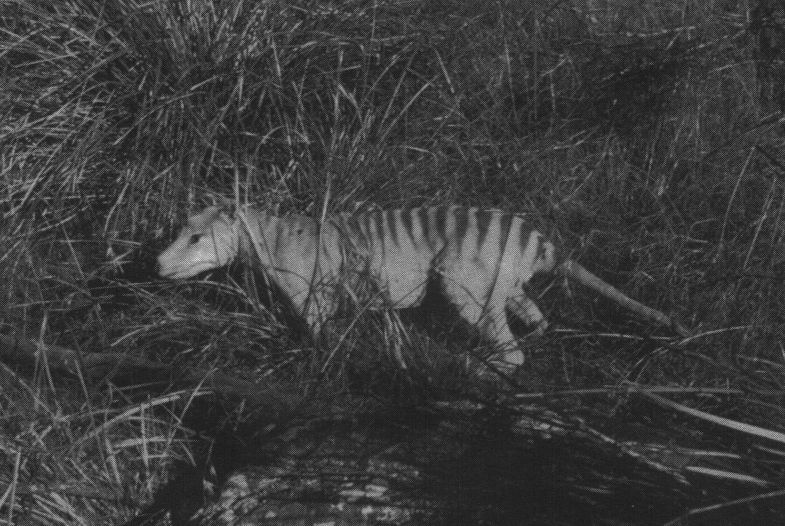
Tasmanian Tiger
Of course the TV chaps arrived too late, and, with their late shooting, ensured the tiger would keep away, making me very disappointed. They insisted that they did not need to use the string as they would not go to sleep. At 1a.m. the photographer told me he woke upin the pitch black of night hearing an animal crunching bones beside him. His hair stood on end, but then he rallied and photographed a devil alongside him with its mouth open.
Houses were then built and dogs used for stock work and that was the last experience we had of the tiger. In retrospect I know I should have organised it better, but at that time I was extremely busy working long hours and left it to the TV operators.
Although both my parents have seen Tasmanian Tigers in the wild, I have never personally seen one, but as mentioned, my previous staff did in 1964 at Wyambi and in early years other staff did in the Arthur River area.
Tourists will also see the 11 large irrigation dams, 200-odd farm dams, plus springs, and 108 miles (174 ldlometres) of gravitation water races and syphons which are unique and will help make their stay all the more interesting. They will see the working of a large property, with 37 miles (59 kilometres) of public roads, plus a similar number of private roads. Also to be seen will be the day by day handling of 50,000-odd Spanish Memo sheep and 12,000-odd cattle on the 69,017-acre (27,930-heclare) property. Some of them may be able to go along with some of the staff on horseback gathering the cattle.
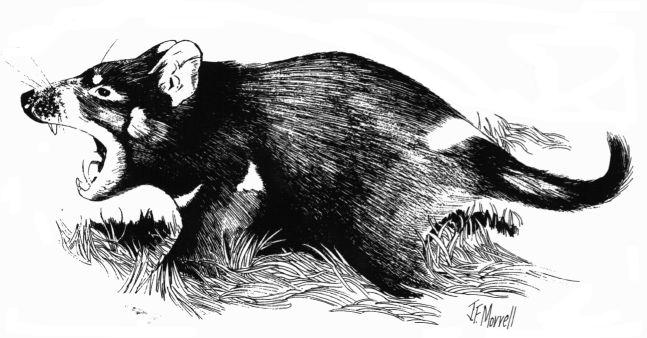
Tasmanian Devil
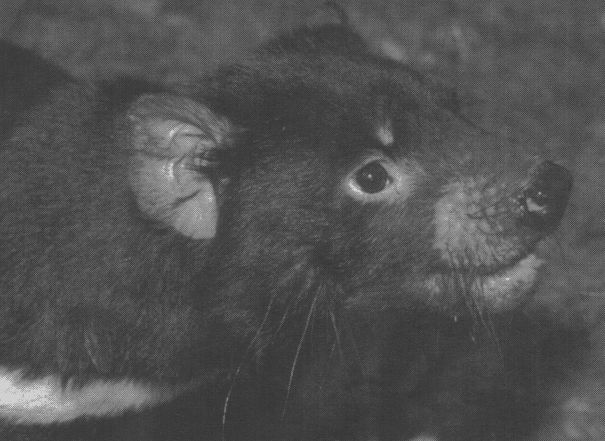
Tasmanian Devil
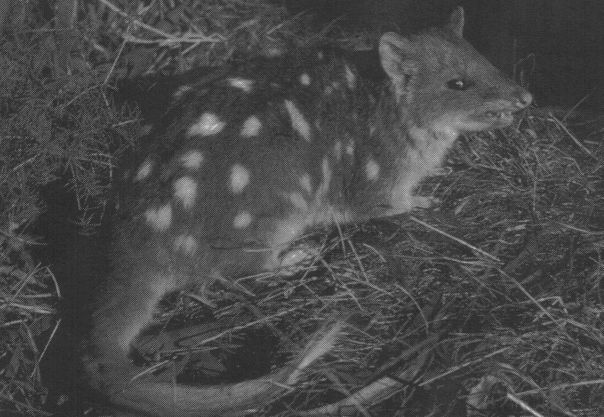
Tiger Cat
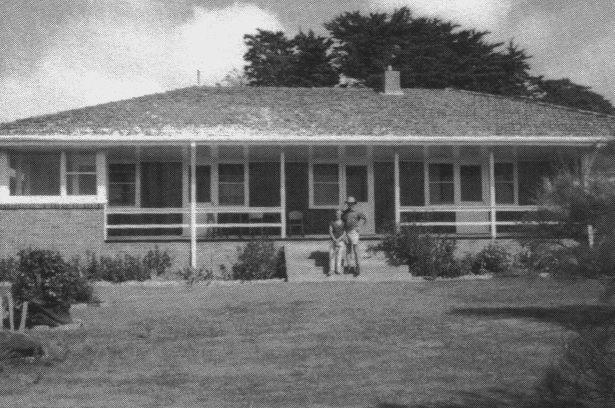
Peg and I overlooking the property from front steps of our Rushy Lagoon house.
This project is not an ordinary tourist venture, and, although these visitors are very important, their activities are secondary to the running of the property and must in no way interfere with day-to-day activities.
On the following two pages is an extract from the 'Tasmanian Wildlife Observation Tours'.
Even if our jobs are tough we do not have to be uncaring and inconsiderate to others.
For example, we had a visit to our property by John Miller, who had spent many years in public relations with Scotland Yard. He came with his father, and although he had been engaged in many tough problem areas and had to associate with many undesirable elements, he was still a thoughtful, caring person.
Although a tough individual, John would not run over a little porcupine that crossed the road in front of our car; or apparently any other living thing if it could be avoided. He was particularly interested in the wombats, and expressed the hope that visitors did not steal them from us. I was able to assure him that we had plenty to spare, for the wildlife people, after an official random two-hour count, confirmed that we had many more wombats than sheep, of which we have more than 50,000. He was pleased also when I told him we also had at least 50,000 Tasmanian devils on the property (but this quantity causes problems). I feel there is hope for the world with people like John and others of similar disposition in our midst.
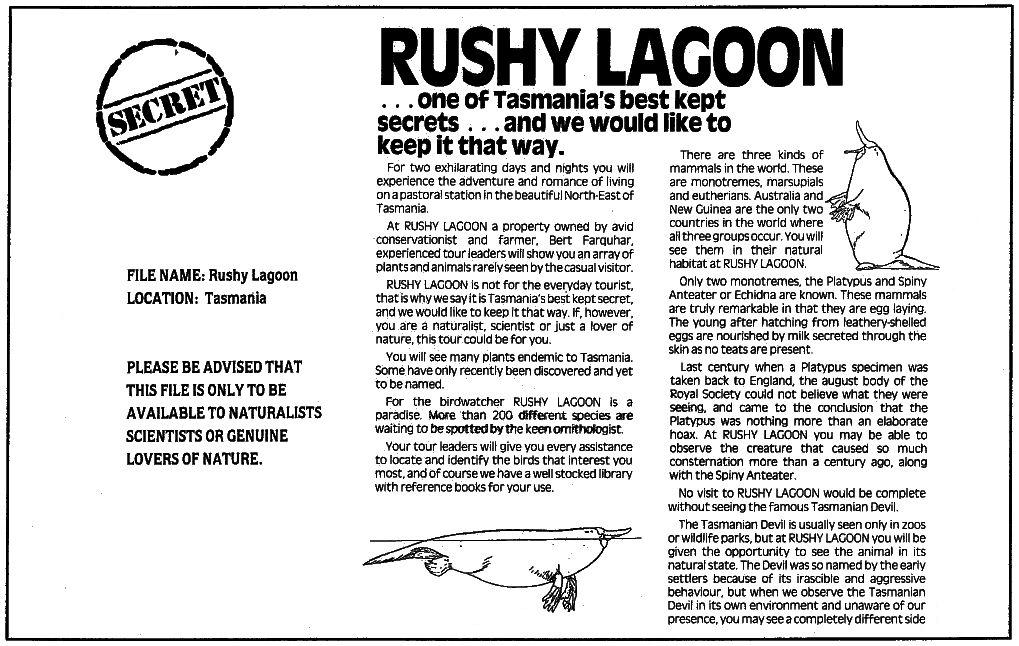
Rushy Lagoon tour pamphlet 1
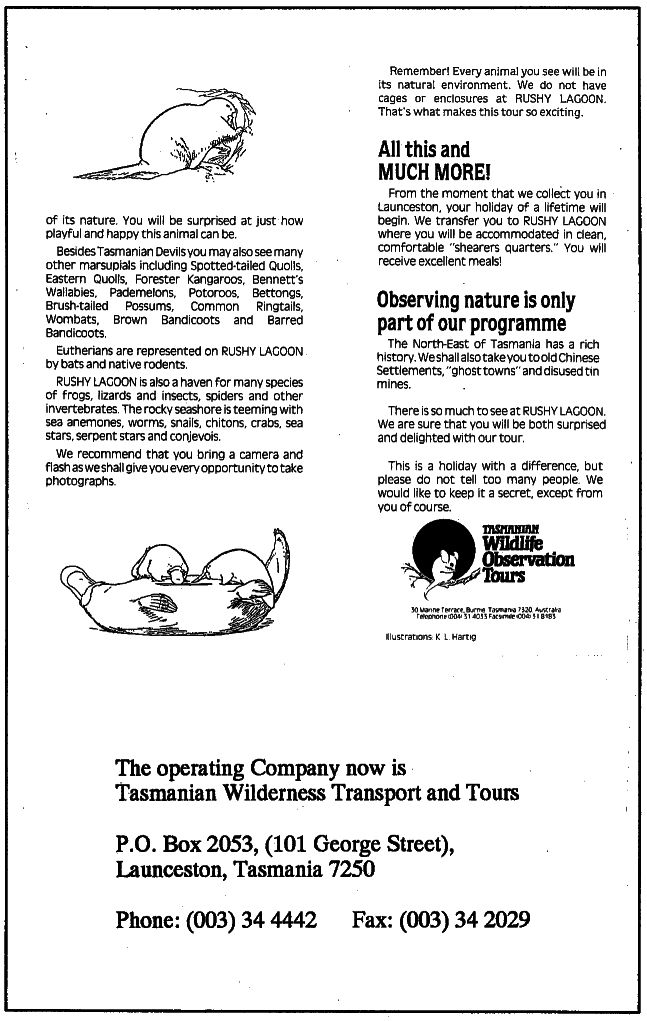
Rushy Lagoon tour pamphlet 2
Actually people are generally becoming more compassionate, though very gradually. I would hope that crowds would not want to watch a hanging as they did years ago. I really think that despite all our present problems and crimes, the human race is generally improving. Although too much alcohol is consumed, there are not the drunks around the streets as was the case when I was a kid.
Old Mr. John Groves, who used to own the majority of Rushy Lagoon, was apparently a great old individual and a pretty good judge of character. However, the story goes that if there was a newcomer and he did not know his character, he would send him upstairs where there were hundreds of dollars lying, to fetch a wrench or some such item. Then the old chap would go up and just check whether all the money was still there. This was a method he used to see whether that person would be honest in future dealings. Quite an unusual, but sound way of doing things.
When we took over Rushy Lagoon four years ago there were some fifteen houses on the property, which has provided us with a heart-warming experience.
Not all of them were being used by staff, so we lent about seven to people as holiday homes, as long as they looked after them. Jim Bowen, Ron Pendlebury, Wayne Joyce and Martin Vogelpoel have done their homes up beautifully, and now we have others doing the same, for all are taking pride in them.
Apparently the previous owners would not allow them to be used unless normal rent was paid for them, and when we took over they were in some disrepair.
We felt it cost us nothing to make these homes available and our gesture had turned out to be an advantage. As an asset the houses have increased in value, for the present occupants have done them up and painted them. Some of the people are now on our staff, others are on social service, or special pensions with their families. They have appreciated the fact that the houses are practically rent-free and are quite proud of them. The homes are not costing them very much, but they are not costing me anything either. Whereas a home was theoretically worth $35,000 new, it had dropped in value through neglect. Now the value is increasing.
Of course, I have an agreement that I can take them back should they be needed. If the occupants have done a lot of work on them I would pay them, a nominal amount, but if the cost was only reasonable in return for living in the homes and the joy of improving them, both parties would gain considerably.
There is dry wood available in close proximity to their homes for wood burners. Wood heaters are very popular now in Tasmania. They produce a cheap, efficient pleasing form of heat.
If green eucalyptus timber is used for wood from heads of trees already cut down for chips or timber, it is desirable to use it from a tree that has just been fallen in the Spring, preferably about November. The tree has the greatest amount of sap in the trunk during the Spring growth.
When the green cut wood dries out, over a period of about twelve months, one tonne of this volatile wood is equal to about twice the tonnage of ordinary wood. It burns so well because it still has retained the sap in the wood, but in a cured dried form, whereas the sap in a dry tree has returned to the ground during it's dying process.
The area is a pleasant place to live, and there is beautiful fishing within six miles on the western and eastern sides of Rushy Lagoon, depending on which direction the wind is blowing from.
It has been a wonderful opportunity for people who have been prepared to and have known how to help themselves. We have a wonderful area in the North-East of Tasmania. Most of the people in this old mining area are really genuine. They have had to work hard and they are the salt of the earth, and Jam very proud to be one of their friends and work with them.
The film 'The Tasmania Story' has been a great success in Japan. People worldwide wish to come and see our unique wildlife under natural relaxing conditions.
We do not realise how very fortunate we are in having such a wonderful life-style, living in a free, unpolluted area where the land, air, water, rivers and beaches are so lovely. The animals and birds have to be seen to be believed.
We must make facilities available, so that visitors from Australia and overseas can visit our area to see the many wonderful animals and birds personally We have a great future as long as Governments and Departments realise the potential and act accordingly In the meantime it is everyone's responsibility to see that our natural heritage is cared for.